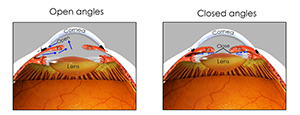Open and Closed Iridocorneal Angles

What are Open and Closed Iridocorneal Angles?
The eye is made up of two chambers that are filled with a clear gelatinous fluid called aqueous humour which lubricates and maintains the shape and intraocular pressure of the eye. This pressure is maintained by the balance in the production and drainage of the fluid. The iridocorneal angle is the angle formed by the iris (coloured part of the eye) and cornea (transparent, dome-shaped layer covering the eye) to allow the drainage of the aqueous humour from the eye.
Anatomic abnormalities such as the narrowing or closing of the iridocorneal angle cause difficulty in drainage of aqueous humour and increase the intraocular pressure. This condition is called glaucoma. Depending on the angle made by the iris and cornea, glaucoma can be categorized as open or closed iridocorneal angle glaucoma.
Open iridocorneal angle glaucoma is the primary stage and the most common form of glaucoma. The angle between the iris and cornea appears wide and open as it normally should, but the drainage of aqueous humour gets clogged.
Closed iridocorneal angle glaucoma is less common glaucoma where the drainage of aqueous humour is completely blocked as the angle between the iris and cornea is closed. The condition causes permanent damage to eyesight if left untreated.
Related Topics:
- Uveitis and Ocular Inflammation
- Dry Eyes
- Lid Cysts
- Blepharitis
- Glaucoma
- Retinal Tear
- Cataract
- Diabetic Macular Oedema
- Retinal Vein Occlusion
- Macular Oedema
- Cystoid Macular Oedema
- Central Serous Retinopathy
- Vision Disorders
- Watery Eye
- Tear Duct Obstruction
- Vein Occlusion
- Chalazion
- Vein Occlusion Macular Oedema
- Allergic Disorders of the Eye
- Blurred Vision
- Distortion of Central Vision
- Ocular Ischemic Syndrome
- Optic Neuropathy
- Posterior Uveitis
- Proliferative Diabetic Retinopathy
- Temporal Arteritis
- WET AMD
- Traumatic Iritis
- Acute/ Chronic/Recurrent Iridocyclitis
- Am I at Risk of Glaucoma?
- Epiretinal Membrane
- Open and Closed Iridocorneal Angles
- Pars Planitis/Intermediate Uveitis
- Retinal Detachment
- Subconjunctival Haemorrhage












